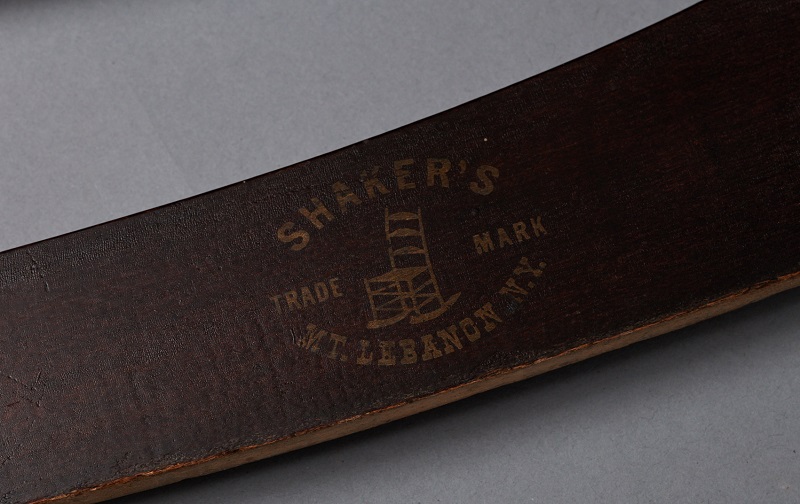
Detail of a #4 rocking chair, showing the gold Shaker trademark decal on the inside of one rocker. Shaker Museum | Mount Lebanon 1962.13806.1. John Mulligan, photographer.
In September 1872, a notice appeared in The Shaker periodical that, “Mt. Lebanon is alive to many new things. The South Family is building an extensive chair factory, with tenant houses attached. A thousand-dollar engine from Haskell’s Albany works is to drive the machinery.” Under the direction of Elder Robert Wagan, the new factory represented […]
In September 1872, a notice appeared in The Shaker periodical that, “Mt. Lebanon is alive to many new things. The South Family is building an extensive chair factory, with tenant houses attached. A thousand-dollar engine from Haskell’s Albany works is to drive the machinery.” Under the direction of Elder Robert Wagan, the new factory represented a pivot toward mass production of what became among the best-known of all Shaker goods. The chair industry also serves as illustration of how the Shakers evolved the presentation and marketing of their goods to the outside world.
On February 13, 1872, a Mount Lebanon Ministry journal recorded that, “Br. Robert Wagan comes to Ministry’s Shop to see us concerning obtaining of the Second Family the old West House, Barn, and Gardens, or, an equivalent in money, to aid in building a new chair factory.” The production of chairs became an important industry at the Second Family beginning in around 1850; in 1852, George O. Donnell of the Second Family secured a patent for tilters placed on rear legs of side chairs. In 1863, the South Family was formally separated from the Second Family, and Brother Robert Wagan was named its trustee. As Elder Henry C. Blinn noted in 1872, “Br. Robert is enterprising. He says anything will sell that is carried into the market.”
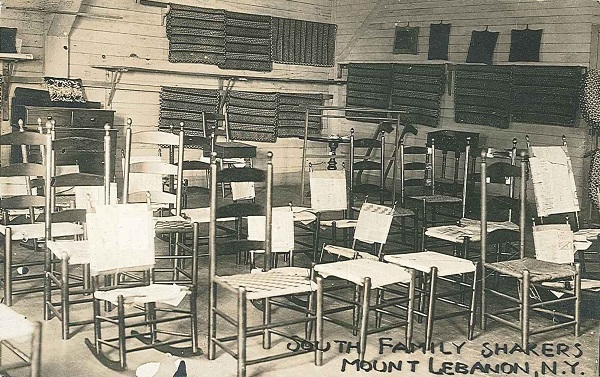
Picture postcard showing the showroom of the Chair Factory at the South Family, Mount Lebanon, NY. Shaker Museum | Mount Lebanon 1950.4097.1
In addition to building the factory, Elder Robert updated other aspects of the business as well; for example, the steam engine purchased for the factory permitted production year-round. But an important change in business practices was how Elder Robert promoted and marketed his wares. In 1874, he published the first bound catalogue that included engraved illustrations of the different types and styles of chairs available; numerous catalogues were published in succeeding years, some including oval boxes for sale. And in 1876, Wagan, along with representatives from the Church Family, displayed their wares at the major exposition held in Philadelphia to commemorate the nation’s centennial.
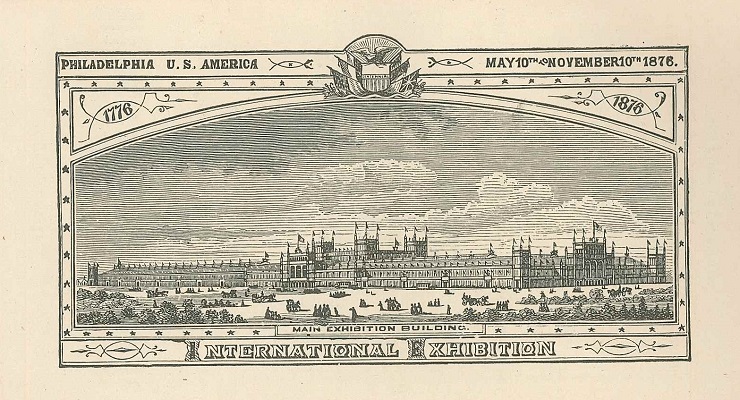
Page from the catalogue published by Elder Robert Wagan for the 1876 Centennial Exhibition, showing the main building of the exhibition. Shaker Museum 1961.13422.1.
The Shakers had not always embraced similar opportunities to raise awareness and promote their products. In 1853, Theodore Sedgwick, president of the organization that developed the Exhibition of the Industry of All Nations held at the Crystal Palace in New York City, wrote a letter to the Shakers stating, “I am very familiar with the intelligence and industry of your Community,” and inviting them to exhibit at the fair. However, the elders concluded, “We cannot feel that it is right or necessary for us to intermingle with the world in such like companies of speculation.”
Yet by the time of the 1876 Centennial Exposition at Philadelphia, it was proudly noted in The Shaker that, “The Church Family, Mt. Lebanon, purpose exhibiting some of their manufactures at the Centennial. Also, the South Family have secured space to display their Shaker Chairs…. We were pleased to notice that Bro. R. M. Wagan has issued a musical and historical circular of Shakerism for Centennial circulation; and has so ingeniously blended chairs, music and history together therein that the people cannot see the pictures of chairs, without being forced to learn our history and our songs! Will not all other Trustees be as anxious to dispense the gospel? We doubt not that while he thus magnanimously circulates such valuable information, he will also sell many of his chairs!”
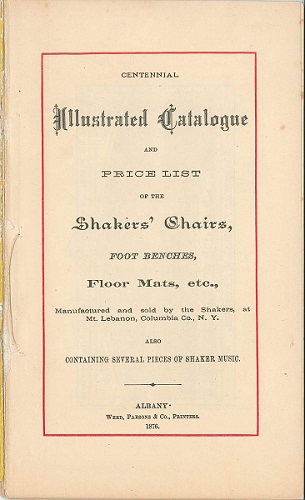
Title page, “Centennial Illlustrated Catalogue and Price List of the Shakers’ Chairs…” produced by Elder Robert Wagan for the 1876 Centennial Exhibition. The circular also included Shaker songs and an overview of the Shakers and their history. Shaker Museum | Mount Lebanon 1961.13422.1.
Elder Robert’s efforts may have inspired similar changes in other Shaker industries, or perhaps the Shakers were simply trying to adapt to the times. On July 1, 1884, a Mount Lebanon Church Family journal noted, “An artist from New York is here sketching some pictures of our extract laboratory and works, and the medicine buildings and rooms, for [distributor of Shaker medicine] Dr. White to publish in a pamphlet.”
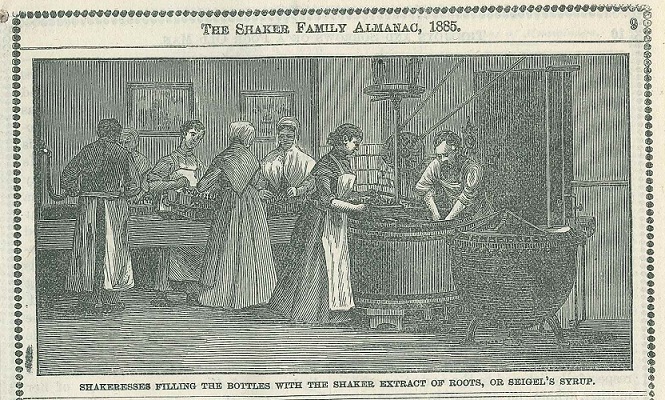
Illustration from an almanc published to promote Shaker’s Extract of Roots or Seigel’s Syrup, a medicine made by the Shakers and distributed by A. J White. Shaker Museum | Mount Lebanon 1979.19075.1.
And on January 1, 1885, it is recorded in the same journal that, “Efforts are being made to revive the seed business by instituting improved seed boxes, and seed bags printed in [chromolithographs],” as well as “introducing new improved labels and printing 20,000,000 [sic] advertising pamphlets.”
In 1901, Sister Emma J. Neale took over management of the cloak workshop at Mount Lebanon, which was renamed “E. J. Neale & Co.” Like Elder Robert, Sister Emma possessed excellent business skills and she continued many of the same practices, issuing promotional material such as bookmarks and even posing for the photograph that was used for illustrations.
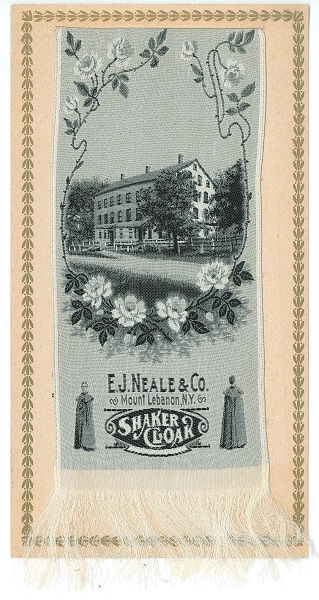
Bookmark advertising “E. J. Neale & Co. Shaker Cloak”; Sister Emma J. Neale is shown modeling a cloak. Shaker Museum | Mount Lebanon 1954.6853.3.